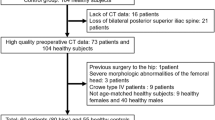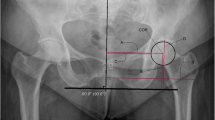Abstract
Objective: To analyse in detail the two methods for the measurement of the center-edge (CE) angle in developmental dysplasia of the hip (DDH) in children and adolescents. Design: Four observers independently interpreted the radiographs of 51 surgically treated and 15 unaffected hips on two occasions. CE angle was measured by using two methods: classic (Wiberg) and refined (Ogata et al.). Intraobserver and interobserver variations of both methods were calculated and the effect of age and treatment type on the two measurement methods were analysed. Results: Following 528 measurements in 66 hips, the mean classic CE angle was 28.2° and the mean refined CE angle, 19.9°. The classic CE angle had nearly 1° less intraobserver and interobserver variation than the refined CE angle. Classic angle measurements were obviously higher than refined ones in the hips of children under 9 years of age and in hips in which an innominate osteotomy had been performed. Conclusion: Although CE angle of Wiberg, which is an important radiographic indicator, has an adequate level of reliability and reproducibility it may not reflect the true lateral femoral head coverage in some cases.
Similar content being viewed by others
Author information
Authors and Affiliations
Additional information
Revision accepted: 29 May 2001
Electronic Publication
Rights and permissions
About this article
Cite this article
Ömeroglu, H., Biçimoglu, A., Aguş, H. et al. Measurement of center-edge angle in developmental dysplasia of the hip: a comparison of two methods in patients under 20 years of age. Skeletal Radiol 31, 25–29 (2002). https://doi.org/10.1007/s002560100402
Received:
Published:
Issue Date:
DOI: https://doi.org/10.1007/s002560100402




